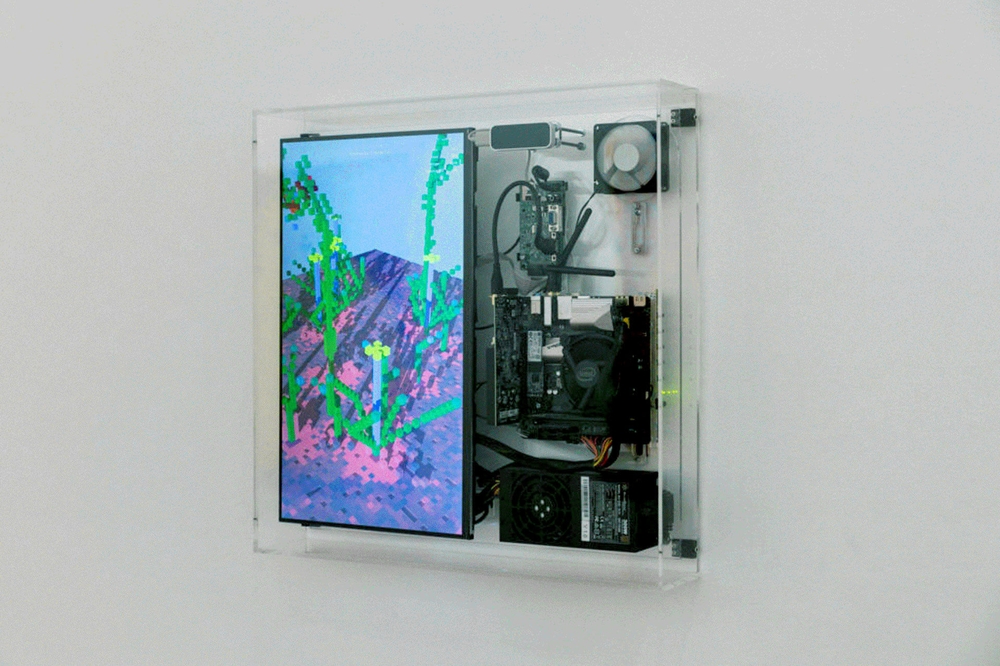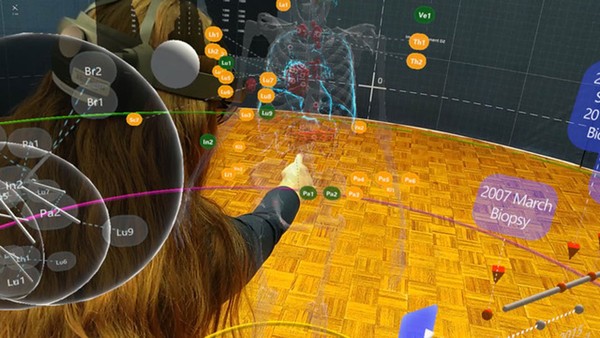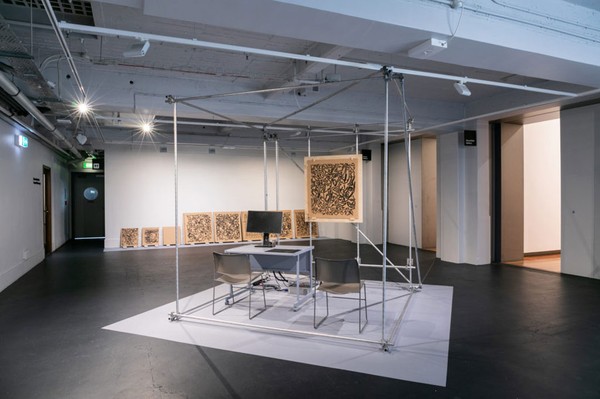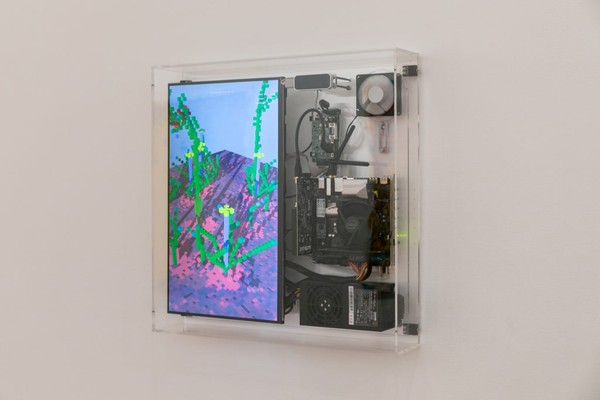“It was not only the patient who was relieved from pain by anaesthesia. The effect was profound upon the surgeon.” [1]
Susan Buck-Morss
Anaesthesia is not only a medical tool. Long ago I read Susan Buck-Morss’s essay about anaesthetics, in which she characterised it as an aspect of aesthetics—an aspect, that is, of the sensory relations we have with the world around us, with art but not only art. Anaesthetics is part of aesthetics and also its opposite, the very lack of sensory relation, the blocking of the senses that is, perhaps, necessary to sensing in the first place, but which brings dangers of its own. I was reminded of the idea of anaesthesia when I picked up Cressida Heyes’s recent book on the topic, and once again started seeing it, or not seeing it, everywhere.[2]
Buck-Morss writes about anaesthesia, in the wider sense, as a response to the impact of modernity. Her essay deals with the shocks of the European 19th and early 20th Century modernity that interested the critic Walter Benjamin:
- the shock of the battlefield and the need to block out the wounded soldiers’ cries of pain,
- the shock of the factory, and the desire to turn away from the clamour of the workers,
- the industrialising city, and the need to avoid the faces of strangers on the streets.
Anaesthetics, that is, involves a meeting and a way to manage the sensory overload of that meeting. It involves work on the self as well as on the other, showing a body even as it obscures it. In the medical setting, it might be applied as much for the surgeon’s sake as the patient’s: the surgeon can operate without having to tolerate the movements, and the cries, of the patient. The patient is made passive, an object to be opened and fixed and a demonstration object for medical students to look on, even while the surgeon is made numb to the wounds they cause.
The same numbness that is put to use for healing can also be associated with war. As Buck-Morss says:
The theme of the autonomous, autotelic subject as sense-dead, and for this reason a manly creator, a self-starter, sublimely self-contained, appears throughout the nineteenth century—as does the association of the “aesthetics” of this creator with the warrior, and hence with war.[3]
We might associate this anaesthetic with the colonial—the deadening of colonial subjects, and of land itself, making it into something unfeeling to be occupied by similarly sense-dead colonists, and transformed to plan. And we might associate it with the virtual. In his Serious Games series (2009-10) artist Harun Farocki explored how virtual reality and videogame technologies were used by the US military to recruit personnel, train for battle and recover from trauma. They overlaid a virtual world on the real one. I wondered, watching his videos, about whether overlaying the world with another world was always about measurement of it and movement in it, about perfect knowledge and colonial mastery of it, the ability to touch it without feeling.
Like Buck-Morss, I associate the ambiguity of anaesthetics—the traumatic meeting controlled through numbness—with photography. Photographs, diagnostic and evidentiary, make their subjects into inert objects of study. But here is Ariella Azoulay, who writes about photography and politics in the context of Occupied Palestine:
[N]o photographer, even the most gifted, can claim ownership of what appears in the photograph. Every photograph of others bears the traces of the meeting between the photographed persons and the photographer, neither of whom can, on their own, determine how this meeting will be inscribed in the photo.[4]
Azoulay believes this even when the photographer is the colonial, surveilling state. Even, that is, where the photograph is made for the purposes of control, the subject can be recognised in it, for their place in the meeting it emerges from. The photographed subject can live in the photograph and look out from it, and the photograph itself might be rescued from the state archive and find another life in other contexts.
In this article I want to ask what digital anaesthetics might be, and to tease out some thoughts about its relation to digital aesthetics. Digital anaesthetics means, at the very least, a sensitivity to what is both shown and obscured, often deliberately, in the meeting with and via digital technology. In one story, digital technology was supposed to be all about connecting, bringing the world together. It would allow us to find information, connect with strangers, and receive messages from afar. The promise of the digital seemed to be the promise of a new politics taking place in a virtual town square—‘Here comes everybuddy’, as Andy Merrifield put it a few years ago. [5] What crowds might form online, what impressions and information might be brought to us.
However, digital technologies are also about the management of the very crowds they invoke—making them simultaneously appear and disappear. Technologies, that is, emerged for anaesthetising oneself against the clamour of the networked crowd. Almost as soon as network technology opened the possibility of conversations with strangers, it offered ways (often justified) to ignore them. Even before digital networks, as Tung-hui Hu has documented, telephone party lines had to be managed by codes of neighbourly good behaviour to make sure private conversations could carry on without interruption or eavesdropping by others on the line.[6] It was a problem later solved by technology itself: dedicated household phone lines, and eventually individual devices and user accounts, allowing anonymity, selectivity and blocking of other users.
It isn’t only the fact of networked encounter that requires management. Uber exemplifies the anaesthetics of digital platforms that enable monetary transactions. Uber makes the transaction disappear into the background of the encounter between an Uber driver and a passenger, so that money—the very reason the driver is there—need not be mentioned. The passenger is connected with the driver while also anaesthetised from their experience.
Digital technology offers anaesthetics not only against the presence and needs of other living people, but also against its own workings and the histories and labour built into it. Computer source codes, for example, developed as a way to routinise interactions with programmable machines and allow a degree of human fluency in programming, but also obscured the technical layers necessary for code to be implemented. Where programming of the earliest computers such as ENIAC involved physical operation of, and intimacy with, the machine itself, source code renders the computer abstract and obscure, even while seeming to provide those fluent in its language a window onto its workings.[7]
*
A project made under the auspices of Auckland University’s arc/sec lab and featured at this year’s Ars Electronica Garden Aotearoa shows how digital virtualisation can overlap with medical anaesthesia. arc/sec specialises in projects that combine and overlay physical and virtual structures, and their 3D Tumour Evolution Model (2020-) does so in an explicitly aesthetic and anaesthetic way. Less of an art project than a medical one, 3D Tumour Evolution Model hopes to make use of subject-specific tumour modelling, projecting scanned and modelled tumours from patients onto a three dimensional virtual space that medical professionals can enter and interact with using XR goggles. The space is rich with data: scan images are displayed, and diagnostic information is accessible via virtual interactive and pop-up screens. In the space, the sensory reception of information is managed to avoid ‘overload’.
[arc/sec] 3D Tumour Evolution Model (2020-). Still. Image courtesy [arc/sec]
3D Tumour Evolution Model is, it should be clear, both about the presentation of information to the senses and about the blocking of sensation. In the case of the virtual body, the aesthetic aspect of medical anaesthesia is perfected: the body can be explored, discussed and prodded with no discomfort, pain or embarrassment for the subject, who is absent altogether. As in much of arc/sec’s work, the physical world is overlaid with a ‘digital twin’ that allows the simultaneity of physical and virtual movement, so that the physical body can interact with virtual objects. Goggle images show a twin body for the wearer—a virtual hand almost, but not quite, moving with their flesh and blood hand. It is an anaesthetised body that one might dispassionately watch, punctured and cut by virtual objects. Virtuality, then, operates as an anaesthetic of care. This is literally the case—it is an alternative to medical anaesthesia. Much as medical modelling can act as an ethical alternative to human subjects research, the interaction with a virtual tumour model may offer alternatives to invasive diagnostic procedures.
*
Data can anaesthetise its subjects. It is hard to hear the voice of the subject speaking through the spreadsheet. Social data both constructs and anaesthetises the social body. Whenua is anaesthetised into land by the operations of settler colonialism; it is made empty and inert, sense-dead and able to be operated on, and the colonist sense-dead to it, seeing it only as a map and a place to be made over (‘acclimatised’) into an imagined utopia.
Earlier this year one of my students sent me a link to Sinead Overbye’s wonderful, critical engagement with Simon Ingram’s work Monadic Device (2021).[8] The work, like a lot of Ingram’s, is a machine for making paintings based on input from a sensing device. It is a sensing apparatus, an algorithm in a box, and a robot arm. In this case, the apparatus senses the brainwaves of a participant, and uses the data for its compositions.
Simon Ingram, Monadic Device, 2021. Simon Ingram in collaboration with John-Paul Pochin, Robert Spite and Kamahi Electronics. 2.3×2.3×2.3m. Custom software, computer, electronics, aluminium, cardboard, brush, oil paint.
Overbye participated in the work, making a painting through her brainwaves. In her writing she paints another picture: herself plugged into the machine. She has it right when she says that, by participating, she is willingly repeating an old colonial trope: the indigenous woman in the artwork: ‘It feels so invasive and ethnographic; I almost expect a colonial settler to pop out with his camera flashing unashamedly and yell, “Aha! We have captured a native Māori!”’[9] I think what Overbye manages so well is to link two kinds of exploitation: on the one hand, the artistic exploitation and objectification of the colonial subject à la Gauguin—here is a frame, a technological one, placed around a brown woman’s body—and on the other, data colonialism, the extraction of social and medical data that colonised people are constantly subject to, and its use as a resource for control and profit.
Overbye talks about her discomfort being plugged into technology, about her distrust of it. But at the end of her piece she could write, ‘This artwork is meaningful only to me and I think, maybe it is mine.’ [10] Even though it came out of a surveillance apparatus, it was hers, her data and her creation. You might say it was her kin. As Callie Corrigan, for example, has said at the 2019 Māori Data Futures Hui, ‘Data has a beginning and from that, it has whakapapa. Data becomes a taonga if its whakapapa, its connection, its creation, its relationships and its environment, connect to our people and our knowledge or taiao as Māori’. [11] Cutting that connection becomes an act of colonial anaesthetics.
‘Data has a beginning and from that, it has whakapapa. Data becomes a taonga if its whakapapa, its connection, its creation, its relationships and its environment, connect to our people and our knowledge or taiao as Māori’
Overbye’s writing makes clear the complexities of the meeting with the device, and of what emerges from it. She chooses to experiment with a situation of colonial anaesthetics, a situation that resembles those in which so many colonial subjects, painted or photographed, have been shown and anaesthetised. For all that, her thoughts are seemingly on display for all to see, through the painting, even as it is being made. And still they aren’t—they are made over into unspeaking data, and obscured by the abstraction of the painted image and, it might as well be said, by the fact that brain waves tell us nothing much about thoughts in the first place. If the painting is anaesthetised interiority—thoughts simultaneously displayed and obscured—Overbye’s writing nonetheless works to re-establish her ownership or, better, her kinship with it.
*
In one of the galleries adjacent to Monadic Device was a series of works made by Ingram with collaborators from the collective Terrestrial Assemblages. Earth Models (2020, with John-Paul Pochin) are unboxed computers running soil modelling software, with model simulations visualised on the screens. In these works, there is the aesthetics and anaesthetics of the machine itself—it is revealed, but its workings still obscure. In these works there is perhaps an anaesthetics of care on display, a way to experiment with nature that, as with larger planetary models, leaves nature itself alone. In the nearby Hyperspectral Camera (Terrestrial Assemblages, 2020, with Robert Spite) a decaying apple is dissected through hyperspectral scanning, but is also left physically unharmed by the process—and the same goes, more abstractly, for the modelling of nature on display on the other screens (even while, as with all digital technology, the more distant environmental damage caused to nature is invisible). As in the medical case, then, there is no easy ethics associated with the numbing of the senses—it can enable care for the body as much as it can allow violence towards it.
And, what the Earth Models screens have to show is the fullness and interconnectedness of nature. There is, to be sure, virtualisation and control, the making of deadened space in which nothing is felt and experiments can be made with nature, but in the midst of it there is the blooming of plants in their systemic relationships with worms, bacteria, fungi and environmental factors. This virtual space allows a simultaneity of anaesthetics and sensitivity similar, in some ways, to that of the photograph—an objectified, feelingless space, concerned perhaps with the simplification and management of the bewildering complexity of nature, but which also opens up a certain sensitivity to the world, to its cycles and equilibriums.
This simultaneity—anaesthesia and sensitivity, all in the one frame—is a condition that it is, perhaps, the task of the digital arts to navigate. On the one hand, digital artworks offer ways to think through the technological mediation of the shock of encounter and the uses of that anaesthetic to create sense-dead worlds and bodies. On the other, they also offer ways to populate the world, and reveal it in all its fullness. I am thinking, say, also of those locative works of Tracey Benson or Awhiworld, or of Trudy Lane and Halsey Burgund’s Sound Sky (2013), app-based works that allow specific locations to be populated with traces of memory, story or audio as their users move through them. Or alternatively, the curatorial space of Rachael Rakena and Mike Bridgman’s 2020 digital iteration of the Mana Moana project—a darkened, even slightly bewildering visual ocean, giving its audience no sense of measurement or mastery, and populated too by a range of artworks by Māori and Pacific artists.
To think about digital anaesthetics, then, means to think about what digital technologies and digital artworks can do with, and in spite of, their virtuality. As Buck-Morss writes,
In the “great mirror” of technology, the image that returns is displaced, reflected onto a different plane, where one sees oneself as a physical body divorced from sensory vulnerability—a statistical body, the behaviour of which can be calculated; a performing body, actions of which can be measured up against the “norm”; a virtual body, one that can endure the shocks of modernity without pain. [12]
This quote invites more than just judgment of technology. It invites care, perhaps, that anaesthetising technologies are used in the right interests and the right pains avoided. More than that, though, it invites the hope that digital technologies might act not just as a mirror, a tool to armour the image of the self, but also as a glass through which might emerge, clearly or obscurely, a world full to bursting.
Tim Corballis is a Senior Lecturer in the Centre for Science in Society at Victoria University of Wellington, as well as a novelist, art writer and art collaborator. He currently writes on the aesthetics of science and technology, with a focus on climate and planetary image making. His background is in mathematics, philosophy and creative writing, with a PhD in the theoretical humanities. He has also worked as a collaborator on art projects such as the major 2020 Dowse Art Gallery exhibition Human Hand.
Footnotes:
[1] Susan Buck-Morss, ‘Aesthetics and Anaesthetics: Walter Benjamin’s Artwork Essay Reconsidered’, October 62 (1992): 27, https://doi.org/10.2307/778700.
[2] Cressida Heyes, Anaesthetics of Existence: Essays on Experience at the Edge (Durham: Duke University Press, 2020).
[3] Buck-Morss, ‘Aesthetics and Anaesthetics’, 10.
[4] Ariella Azoulay, The Civil Contract of Photography (New York: Zone Books, 2008), 11.
[5] Andy Merrifield, ‘Crowd Politics or, “Here Comes Everybuddy”’, New Left Review 71 (2011): 103–14.
[6] Tung-hui Hu, A Prehistory of the Cloud (Cambridge, Mass.: MIT Press, 2015), 55.
[7] Wendy Hui Kyong Chun, Programmed Visions: Software and Memory (Cambridge, Mass. & London: MIT Press, 2011), 19–54.
[8] Sinead Overbye, ‘Hooked up to Monadic Device’, Pantograph Punch, 15 April 2021, https://www.pantograph-punch.com/posts/monadic-device.
[9] Overbye.
[10] Overbye.
[11] ‘Māori Data Futures Hui: Intellectual Property’ (Te Aurere, Kaitaia: Science for Technological Innovation, Te Hiku Media, Data ILG, 20 March 2019), 27, https://www.sftichallenge.govt.nz/assets/Uploads/Download-PDFs/Maori-Data-Futures-Report-2019.pdf.
[12] Buck-Morss, ‘Aesthetics and Anaesthetics’, 33.
Reference list:
Buck-Morss, Susan. ‘Aesthetics and Anaesthetics: Walter Benjamin’s Artwork Essay Reconsidered’. October 62 (1992): 3–41. https://doi.org/10.2307/778700.
Azoulay, Ariella. The Civil Contract of Photography. New York: Zone Books, 2008.
Chun, Wendy Hui Kyong. Programmed Visions: Software and Memory. Cambridge, Mass. & London: MIT Press, 2011.
Heyes, Cressida. Anaesthetics of Existence: Essays on Experience at the Edge. Durham: Duke University Press, 2020.
Hu, Tung-hui. A Prehistory of the Cloud. Cambridge, Mass.: MIT Press, 2015.
‘Māori Data Futures Hui: Intellectual Property’. Te Aurere, Kaitaia: Science for Technological Innovation, Te Hiku Media, Data ILG, 20 March 2019. https://www.sftichallenge.govt.nz/assets/Uploads/Download-PDFs/Maori-Data-Futures-Report-2019.pdf.
Merrifield, Andy. ‘Crowd Politics or, “Here Comes Everybuddy”’. New Left Review 71 (2011): 103–14.
Overbye, Sinead. ‘Hooked up to Monadic Device’. Pantograph Punch, 15 April 2021. https://www.pantograph-punch.com/posts/monadic-device.



